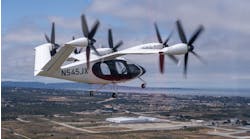In developing leading-edge environmental technology and showcasing it to the world, not all the challenges are technical. One of the biggest challenges faced by the Blue Sky Solar Racing is to put together and continually attract a world class team of engineers, scientists and environmentalists to help design, build and race the cars.
Every two years, a special field of cars competes in the Panasonic World Solar Challenge, crossing the Australian continent powered by nothing but the sun. Teams research, build and design vehicles capable of completing the 3000 km journey from tropical Darwin in the Northern Territory to cosmopolitan Adelaide in South Australia.
The University of Toronto Blue Sky Solar Racing team's fifth-generation car, Cerulean, competed in the 2007 challenge, finishing first among all Canadian entries and fifth overall in its class. Their sights are already set on 2009's competition. According to Andreas Marouchos, managing director of Blue Sky's 2007 Cerulean car, their singular mission is "to demonstrate the viability of alternative energy technology and the practical benefits of a multidisciplinary approach to solving problems."
One would imagine that Blue Sky Solar Racing's most significant challenge would be designing and bu's just one of many issues with which the group deals.
All of Blue Sky's technology is developed from scratch and the members that help put it all together come from the University of Toronto. Most of the students join the team as first or second year engineering students. The team uses Dassault Systmes Product Lifecycle Management tools, including ENOVIA SmarTeam collaborative product data management technology and CATIA virtual 3D design software, in its designs and construction. The team plans to step up the design for their 2009 car using ENOVIA SmarTeam to manage complete assemblies in context, rather than individual parts. This strategy will help them identify opportunities to reduce vehicle weight and increase speed. Dassault Systmes is also a team sponsor.
Needless to say, the students who comprise Blue Sky Solar Racing have a great deal of enthusiasm to help them along. As part of the learning process, new student recruits work with the existing team to learn the science of automotive design and get the hands-on skills and software training that isn't always found in a book. As always, the team works closely with industry and team alumni to collaborate on better and more efficient ways to build parts for the car.
Amy Bilton, chief aerodynamicist for the 2007 car, needed to analyze many different alternatives to optimize the design. With a combination of virtual design software tools, attentiveness to detail and a focus on efficiency, Amy was able to generate 60 separate design iterations for the Cerulean in about five hours, all calculating the available area for solar arrays and resulting effects on power. Such behind-the-scenes victories are constant motivations for the Blue Sky team.
With all the sacrifices of time and effort involved in bringing Blue Sky's cars to life, what does the team gain from the experience? Ultimately, the answer is satisfaction -- for the local community, for the university, for themselves and most importantly for society at large, members of which may someday wake up and see a car very much like the Cerulean in their driveway.
In addition to bringing cutting-edge technology to high-profile events such as the World Solar Challenge and exposing it to the masses, Blue Sky Solar Racing is also working on an organic level to spark the interest and enthusiasm of those who will lead our transition towards alternative energy -- young people.
The Blue Sky Solar Racing team will be attending the 2008 Ecofest Ecology Festival in New York City and the 2009 Canadian International Auto Show, as well as returning to the Panasonic World Solar Challenge again next year -- this time with their eyes on first prize.



